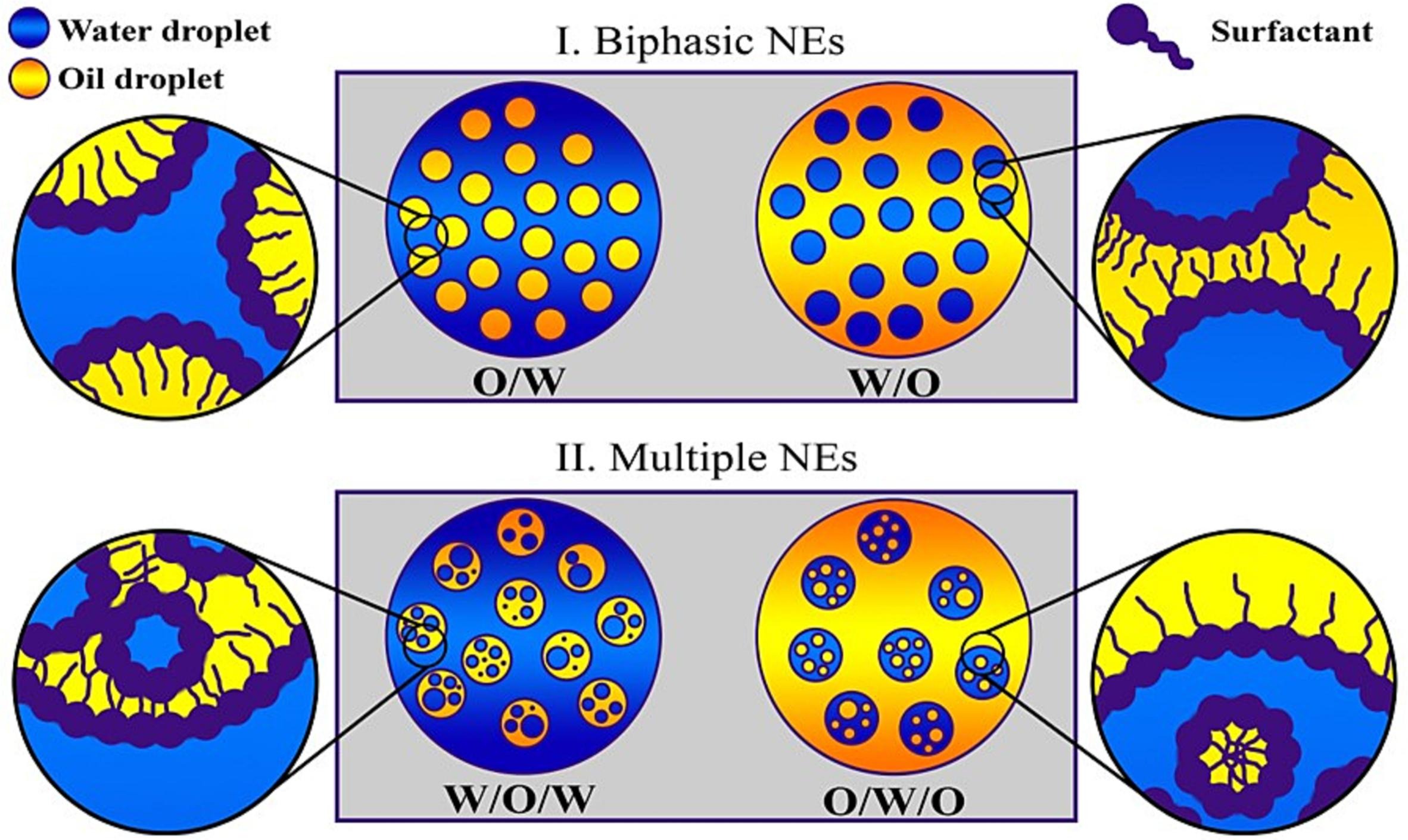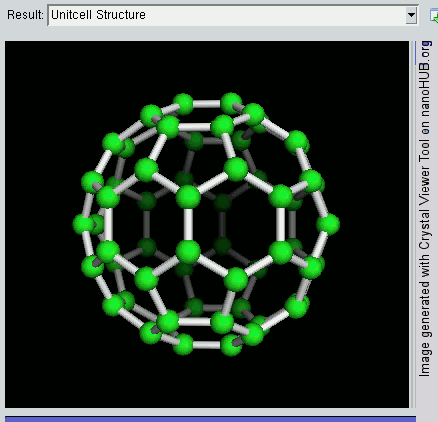|
Nanoemulsions
A miniemulsion (also known as nanoemulsion) is a particular type of emulsion. A miniemulsion is obtained by ultrasonicating a mixture comprising two immiscible liquid phases (for example, oil and water), one or more surfactants and, possibly, one or more co-surfactants (typical examples are hexadecane or cetyl alcohol). They usually have nanodroplets with uniform size distribution (20–500 nm) and are also known as sub-micron, mini-, and ultra-fine grain emulsions. How to prepare a miniemulsion # Selection of ingredients: The first step in creating a nanoemulsion is to select the ingredients, which include the oil, water, and emulsifying agent. The type and proportions of these ingredients will affect the stability and properties of the final emulsion. # Preparation of oil and aqueous phases: The oil and water phases are separately prepared, with any desired ingredients, such as surfactants or flavoring agents, added at this step. # Mixing oil and emulsifier with stirrer: ... [...More Info...] [...Related Items...] OR: [Wikipedia] [Google] [Baidu] |
Emulsion
An emulsion is a mixture of two or more liquids that are normally Miscibility, immiscible (unmixable or unblendable) owing to liquid-liquid phase separation. Emulsions are part of a more general class of two-phase systems of matter called colloids. Although the terms ''colloid'' and ''emulsion'' are sometimes used interchangeably, ''emulsion'' should be used when both phases, dispersed and continuous, are liquids. In an emulsion, one liquid (the dispersed phase (matter), phase) is dispersion (chemistry), dispersed in the other (the continuous phase). Examples of emulsions include vinaigrettes, homogenized milk, liquid biomolecular condensates, and some cutting fluids for metal working. Two liquids can form different types of emulsions. As an example, oil and water can form, first, an oil-in-water emulsion, in which the oil is the dispersed phase, and water is the continuous phase. Second, they can form a water-in-oil emulsion, in which water is the dispersed phase and oil is the ... [...More Info...] [...Related Items...] OR: [Wikipedia] [Google] [Baidu] |
Droplets
A drop or droplet is a small column of liquid, bounded completely or almost completely by free surfaces. A drop may form when liquid accumulates at the end of a tube or other surface boundary, producing a hanging drop called a pendant drop. Drops may also be formed by the condensation of a vapor or by atomization of a larger mass of solid. Water vapor will condense into droplets depending on the temperature. The temperature at which droplets form is called the dew point. Surface tension Liquid forms drops because it exhibits surface tension. A simple way to form a drop is to allow liquid to flow slowly from the lower end of a vertical tube of small diameter. The surface tension of the liquid causes the liquid to hang from the tube, forming a pendant. When the drop exceeds a certain size it is no longer stable and detaches itself. The falling liquid is also a drop held together by surface tension. Viscosity and pitch drop experiments Some substances that appear to be soli ... [...More Info...] [...Related Items...] OR: [Wikipedia] [Google] [Baidu] |
Colloidal Chemistry
Interface and colloid science is an interdisciplinary intersection of branches of chemistry, physics, nanoscience and other fields dealing with ''colloids'', heterogeneous systems consisting of a mechanical mixture of particles between 1 nm and 1000 nm dispersed in a continuous medium. A colloidal solution is a heterogeneous mixture in which the particle size of the substance is intermediate between a Solution (chemistry), true solution and a suspension (chemistry), suspension, i.e. between 1–1000 nm. Smoke from a fire is an example of a colloidal system in which tiny particles of solid float in air. Just like true solutions, colloidal particles are small and cannot be seen by the naked eye. They easily pass through filter paper. But colloidal particles are big enough to be blocked by parchment paper or animal membrane. Interface and colloid science has applications and ramifications in the chemical industry, pharmaceuticals, biotechnology, ceramics, minerals, nanotec ... [...More Info...] [...Related Items...] OR: [Wikipedia] [Google] [Baidu] |
Curcumin
Curcumin is a bright yellow chemical produced by plants of the ''Curcuma longa'' species. It is the principal curcuminoid of turmeric (''Curcuma longa''), a member of the ginger family, Zingiberaceae. It is sold as a herbal supplement, cosmetics ingredient, food flavoring, and food coloring. Chemically, curcumin is a polyphenol, more particularly a diarylheptanoid, belonging to the group of curcuminoids, which are natural phenol, phenolic pigments responsible for the yellow color of turmeric. Laboratory and clinical research have not confirmed any medical use for curcumin. It is difficult to study because it is both unstable and poorly bioavailable. It is unlikely to produce useful leads for drug development as a lead compound. History Curcumin was named in 1815 when Henri Auguste Vogel and Pierre Joseph Pelletier reported the first isolation of a "yellow coloring-matter" from the rhizomes of turmeric. Later, it was found to be a mixture of resin and turmeric oil. In 1910, Mi ... [...More Info...] [...Related Items...] OR: [Wikipedia] [Google] [Baidu] |
Nucleation
In thermodynamics, nucleation is the first step in the formation of either a new Phase (matter), thermodynamic phase or Crystal structure, structure via self-assembly or self-organization within a substance or mixture. Nucleation is typically defined to be the process that determines how long an observer has to wait before the new phase or self-organized structure appears. For example, if a volume of water is cooled (at atmospheric pressure) significantly below 0°C, it will tend to Freezing, freeze into ice, but volumes of water cooled only a few degrees below 0°C often stay completely free of ice for long periods (supercooling). At these conditions, nucleation of ice is either slow or does not occur at all. However, at lower temperatures nucleation is fast, and ice crystals appear after little or no delay. Nucleation is a common mechanism which generates first-order phase transitions, and it is the start of the process of forming a new thermodynamic phase. In contrast, new phas ... [...More Info...] [...Related Items...] OR: [Wikipedia] [Google] [Baidu] |
Nanomaterials
Nanomaterials describe, in principle, chemical substances or materials of which a single unit is sized (in at least one dimension) between 1 and 100 nm (the usual definition of nanoscale). Nanomaterials research takes a materials science-based approach to nanotechnology, leveraging advances in materials metrology and synthesis which have been developed in support of microfabrication research. Materials with structure at the nanoscale often have unique optical, electronic, thermo-physical or mechanical properties. Nanomaterials are slowly becoming commercialized and beginning to emerge as commodities. Definition In ISO/TS 80004, ''nanomaterial'' is defined as the "material with any external dimension in the nanoscale or having internal structure or surface structure in the nanoscale", with ''nanoscale'' defined as the "length range approximately from 1 nm to 100 nm". This includes both ''nano-objects'', which are discrete pieces of material, and ''nanostructu ... [...More Info...] [...Related Items...] OR: [Wikipedia] [Google] [Baidu] |
Analyser
An analyser (British English) or analyzer (American English; see spelling differences) is a tool used to analyze data. For example, a gas analyzer tool is used to analyze gases. It examines the given data and tries to find patterns and relationships. An analyser can be a piece of hardware or software. Autoanalysers are machines that perform their work with little human involvement. Operation Analysis can be done directly on samples or the analyser can process data acquired from a remote sensor. The source of samples for automatic sampling is commonly some kind of industrial process. Analysers that are connected to a process and conduct automatic sampling, can be called online (or on-line) analysers or sometimes inline (or in-line) analysers. For inline analysis, a sensor can be placed in a process vessel or stream of flowing material. Another method of online analysis is allowing a sample stream to flow from the process equipment into an analyser, sometimes conditioning the sampl ... [...More Info...] [...Related Items...] OR: [Wikipedia] [Google] [Baidu] |
Nanoparticle
A nanoparticle or ultrafine particle is a particle of matter 1 to 100 nanometres (nm) in diameter. The term is sometimes used for larger particles, up to 500 nm, or fibers and tubes that are less than 100 nm in only two directions. At the lowest range, metal particles smaller than 1 nm are usually called atom clusters instead. Nanoparticles are distinguished from microparticles (1-1000 μm), "fine particles" (sized between 100 and 2500 nm), and "coarse particles" (ranging from 2500 to 10,000 nm), because their smaller size drives very different physical or chemical properties, like colloidal properties and ultrafast optical effects or electric properties. Being more subject to the Brownian motion, they usually do not sediment, like colloid, colloidal particles that conversely are usually understood to range from 1 to 1000 nm. Being much smaller than the wavelengths of visible light (400-700 nm), nanoparticles cannot be seen with ordinary ... [...More Info...] [...Related Items...] OR: [Wikipedia] [Google] [Baidu] |
Non Particle Analyzer
Non, non or NON can refer to: * ''Non'', a negatory word in French, Italian and Latin People *Non (given name) *Non Boonjumnong (born 1982), Thai amateur boxer * Rena Nōnen (born 1993), Japanese actress who uses the stage name "Non" since July 2016 * NON, a name used by musician Boyd Rice Other uses * Abbreviation of NATO's Allied Forces North Norway Command * ''Non'' (album), The Amenta * ''Non'' (book), a 2009 book by Japanese model Nozomi Sasaki * Non (comics), a villain of Superman in the DC Comics universe * ''Non!'' (EP), Big Country * "Non", a song by Phinehas from the album '' Till the End'' * non, ISO 639-2 and ISO 639-3 language code for Old Norse * NON Records, an independent record label based in Amsterdam, Netherlands See also * nan (other) Nan or NAN may refer to: Places China * Nan County, Yiyang, Hunan, China * Nan Commandery, historical commandery in Hubei, China Thailand * Nan province ** Nan, Thailand, the administrative capital of Nan prov ... [...More Info...] [...Related Items...] OR: [Wikipedia] [Google] [Baidu] |
Homogenizer
A homogenizer is a laboratory or industrial device used to break down and evenly distribute particles within a liquid mixture, creating a stable and uniform emulsion, suspension, or solution. Homogenization (chemistry), Homogenization is a key process in many fields, including food and beverage production, pharmaceuticals, biotechnology, and materials science. It is used to process substances such as tissue, cells, soil, plant matter, and emulsified products like creams, lotions, or milk. Applications Homogenizers are widely used in both laboratory research and commercial manufacturing. Common applications include: * Cell disruption for DNA, RNA, and protein extraction * Food and beverage production (e.g., milk, juices, sauces) * Cosmetic product formulation (e.g., creams, gels, lotions) * Pharmaceutical suspensions and emulsions * Soil and plant sample processing for environmental testing Types of homogenizers A variety of technologies are used in homogenization, each with a ... [...More Info...] [...Related Items...] OR: [Wikipedia] [Google] [Baidu] |
Depth Filter
Depth filters are filters that use a porous filtration medium to retain particles throughout the medium, rather than just on the surface of the medium. Depth filtration, typified by multiple porous layers with depth, is used to capture the solid contaminants from the liquid phase.Derek B Purchas and Ken Sutherland, Handbook of Filter Media (2nd Edition), Elsevier Advanced Technology (2002). These filters are commonly used when the fluid In physics, a fluid is a liquid, gas, or other material that may continuously motion, move and Deformation (physics), deform (''flow'') under an applied shear stress, or external force. They have zero shear modulus, or, in simpler terms, are M ... to be filtered contains a high load of particles because, relative to other types of filters, they can retain a large mass of particles before becoming clogged. Designs available Various designs have been implemented to ensure feasible processes whilst retaining the main objective of depth filters. ... [...More Info...] [...Related Items...] OR: [Wikipedia] [Google] [Baidu] |





